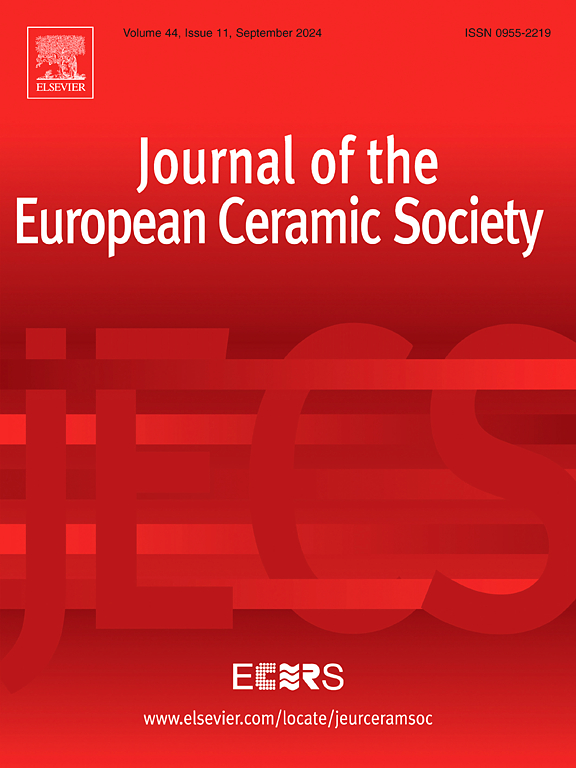采用数字光处理技术制备复合钙钛矿结构Ba(Zn1/3Nb2/3)O3陶瓷和介质谐振器天线的微观结构和微波性能
IF 6.2
2区 材料科学
Q1 MATERIALS SCIENCE, CERAMICS
Journal of The European Ceramic Society
Pub Date : 2025-04-29
DOI:10.1016/j.jeurceramsoc.2025.117492
引用次数: 0
摘要
采用数字光处理技术(DLP)成功制备了具有高b位1:2有序度和优异介电性能的复合钙钛矿结构Ba(Zn1/3Nb2/3)O3 (BZN)陶瓷。采用82 wt%固载率、低粘度、高固化性能的BZN陶瓷浆料制备绿体。样品在真空中进行脱粘处理,然后在1350-1450℃下烧结4 h。具有无序b位结构的烧结BZN陶瓷表现出明显的低介电性能。而在1300℃退火24 h,高b位1:2有序度的BZN陶瓷表现出与干压陶瓷相同的优异介电性能(εr = 38.9, Q × f = 89,600 GHz, τf = 22 ppm/℃)。此外,dlp制作的圆柱形BZN介质谐振器天线的辐射效率为>; 90 %,谐振频率为7.10 GHz (S11 =−29.94 dB),与仿真结果一致。本文章由计算机程序翻译,如有差异,请以英文原文为准。
Microstructure and microwave properties of complex perovskite-structured Ba(Zn1/3Nb2/3)O3 ceramics and dielectric resonator antenna by digital light processing technology
Complex perovskite-structured Ba(Zn1/3Nb2/3)O3 (BZN) ceramics with high B-site 1:2 ordering degree and excellent dielectric properties were successfully fabricated using digital light processing (DLP). BZN ceramic slurry with 82 wt% solid loading, low viscosity, and high curing properties was used to prepare green bodies. The samples were exposed to debinding process in vacuum and then sintered at 1350–1450 ℃ for 4 h. The as-sintered BZN ceramics with disordered B-site structure exhibited significantly low dielectric properties. However, the BZN ceramics annealed at 1300 ℃ for 24 h with high B-site 1:2 ordering degree exhibited excellent dielectric properties (εr = 38.9, Q × f = 89,600 GHz, and τf = 22 ppm/℃) that were identical to those of dry-pressed ceramics. Furthermore, a DLP-fabricated cylindrical BZN dielectric resonator antenna exhibited a > 90 % radiation efficiency and resonant frequency of 7.10 GHz (S11 = −29.94 dB), which is consistent with the simulation results.
求助全文
通过发布文献求助,成功后即可免费获取论文全文。
去求助
来源期刊

Journal of The European Ceramic Society
工程技术-材料科学:硅酸盐
CiteScore
10.70
自引率
12.30%
发文量
863
审稿时长
35 days
期刊介绍:
The Journal of the European Ceramic Society publishes the results of original research and reviews relating to ceramic materials. Papers of either an experimental or theoretical character will be welcomed on a fully international basis. The emphasis is on novel generic science concerning the relationships between processing, microstructure and properties of polycrystalline ceramics consolidated at high temperature. Papers may relate to any of the conventional categories of ceramic: structural, functional, traditional or composite. The central objective is to sustain a high standard of research quality by means of appropriate reviewing procedures.
 求助内容:
求助内容: 应助结果提醒方式:
应助结果提醒方式:


